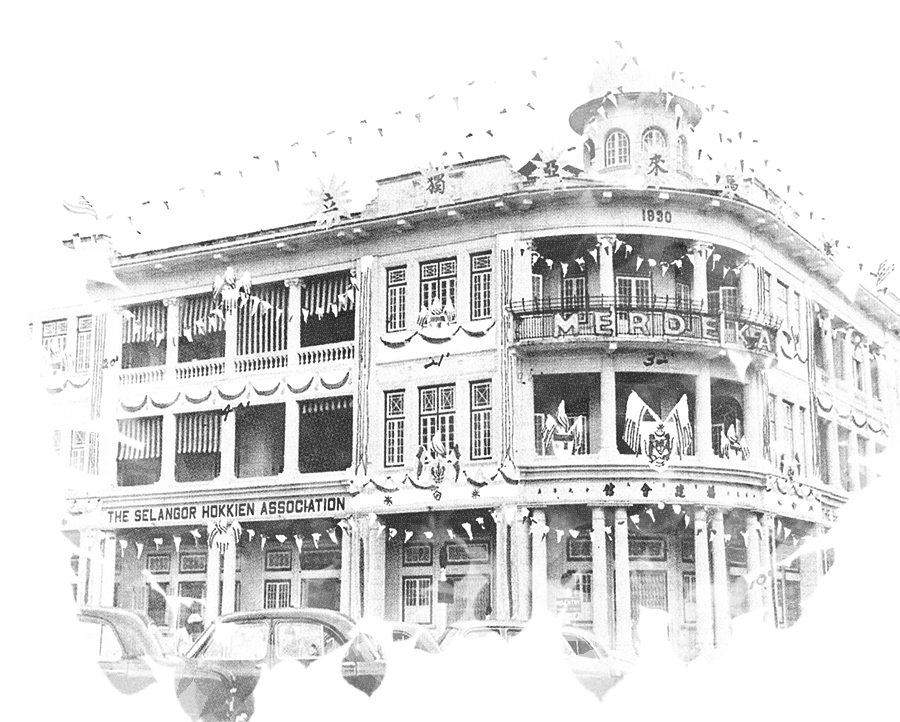The Engchoon Kuala Lumpur History Gallery






Selangor and Kuala Lumpur
Hokkien Association
The Selangor Hokkien Association was established in 1885, just over four years after Kuala Lumpur became the capital of Selangor. This indicates that the Hokkien people had already established a significant presence in Kuala Lumpur during this period. In 1911, the Hokkien population in Kuala Lumpur accounted for 18.41% of the total Chinese population at that time. This demonstrates that the Hokkien community had grown considerably. In addition to having their own association (Hokkien Association), the Hokkien community also managed Wei Zhen Gong, the first temple in Kuala Lumpur dedicated to Fa Zhu Gong, which was under the jurisdiction of the Selangor Hokkien Association.
Wei Zhen Gong was established in 1898 by the directors of the Selangor Hokkien Association. On March 28, 1919, the government officially recognized the temple as a Hokkien temple. Due to its dedication to Fa Zhu Gong, it was early on referred to by the Hokkien people as “Fa Zhu Gong Temple.” The belief in deities from their hometown served as a crucial spiritual support for overseas Chinese immigrants, contributing to community stability. Fa Zhu Gong was the most common folk belief in Engchoon, indicating that the Engchoon people already had significant influence within the Hokkien community in Kuala Lumpur by the 20th century.
In 1926, the Selangor Hokkien Association underwent reconstruction, and at the same time, fundraising for the Hokkien cemetery also took place. The “List of Fundraisers for the Reconstruction of the Selangor Hokkien Association and Cemetery in Kuala Lumpur” shows that the Engchoon people played a vital role in this effort. Among them, the Chief Minister at the time, Huang Zhongji, was one of the founders of the Engchoon Association in Kuala Lumpur. The fundraisers were divided into several groups, with the second group led by Chen Riqiang, and members of Chen Renrang, Yan Panghu, Chen Pengxiang, Hong Jincong, Zheng Meijin, Lin Wanqiong, Chen Duanxiang, Chen Songxiao, Hong Ludun, Lin Bangju, Chen Qitou, Yan Luhu, Lin Shihe, and the seventh group led by Lin Shiyin and Chen Yunzheng, all of whom were leaders of the Engchoon Association at that time.
The establishment of the Hokkien Cemetery serves as another historical marker of the Hokkien people’s settlement in Kuala Lumpur. Although the British colonial government officially designated the Klang area in Kuala Lumpur as the burial ground for Hokkien clansmen on January 16, 1920, a survey conducted by the Hokkien Association revealed that the oldest grave in the Hokkien Cemetery dates back to 1891. The grave belongs to Yap Fat, who was from Engchoon. This indicates that the Engchoon people had already established their roots in Kuala Lumpur for quite some time.
List of the 1926 Selangor and Kuala Lumpur Hokkien Association Building and Hokkien Cemetery Reconstruction Fundraising Committee Members
Source: Provided by Selangor and Kuala Lumpur Hokkien Association

The oldest grave in the Hokkien Cemetery belongs to Yap Fat, a native of Engchoon
Source: Provided by Selangor and Kuala Lumpur Hokkien Association

Among the successive leaders of the Selangor Hokkien Association, the majority were Hokkien people, with a significant number being from Engchoon. The periods of rebuilding the Hokkien Association in 1930 before World War II, from 1950, and during the transformation phase from the 1960s to the 1990s were the times Engchoon people led the association. According to the earliest meeting records preserved by the Hokkien Association, in 1930, Engchoon people held half of the six key positions in the executive committee. Among them were President Chen Riqiang, Deputy Prime Minister Hong Jincong, and Auditor Yan Panggu, all of whom were directors of the Engchoon Association. Among the nineteen committee members, six were confirmed from Engchoon. Before Chen Riqiang’s death in 1934, key positions in the Hokkien Association’s leadership were held by Engchoon people. Even during the period from 1935 to 1954, when the association was led by Hong Qidu from Nan’an, Engchoon people remained a major part of the Hokkien Association’s leadership, with Huang Zhongji serving as president in 1939.
In 1946, the year after World War II ended, the Hokkien Association resumed operations under the continued leadership of Hong Qidu. Among the twenty-five directors, nine were from Engchoon. Notably, Engchoon native Li Yannian began his tenure on the Hokkien Association’s board at this time. From 1972 to 1981, Li Yannian served as president. It is followed by another Engchoon native, Wong Mau-tong, who led the association from 1982 to 1987. In 1976, Li Yannian, in his capacity as president of the Selangor Hokkien Association, also assumed the presidency of the Federation of Hokkien Associations of Malaysia.
Before Li Yannian ‘s leadership of the Hokkien Association in 1972, elections for the board of directors were highly competitive. It is undeniable that the political atmosphere across the Taiwan Strait directly affected Malaysia. During the Nationalist Government era, some leaders of overseas Chinese organizations were members of the Kuomintang’s overseas branches. These leaders actively supported the anti-Japanese resistance during Japan’s invasion of China. After the Chinese Communist Party came to power in 1949, support for the People’s Republic of China began to emerge within overseas Chinese organizations.
Before Li Yannian ‘s tenure, a portion of the Hokkien Association’s leadership consisted of members of the Kuomintang’s overseas branch, who naturally leaned towards Taiwan that was governed by the Kuomintang, in terms of their political identification. However, after Malaysia established diplomatic relations with China and with the subsequent significant increase in Malaysia-China trade activities, it was not surprising that some leaders of Chinese associations, who benefited from this growth, began to shift their allegiance towards mainland China. Rubber, being a major export to China, played a significant role in this shift. Consequently, Li Yannian was labeled by some as a pro-China leader of Chinese associations.
During Li Yannian ‘s leadership of the Selangor Hokkien Association and the Federation of Hokkien Associations of Malaysia, his core team primarily consisted of fellow Engchoon natives. Among them, Wong Mau-tong and Cheng Di served as General Affairs and Treasurer respectively, under Li Yannian’s presidency, forming a solid support base in the Chinese associations that led by Li Yannian.
The Selangor and Kuala Lumpur Hokkien Association was rebuilt with the participation of Engchoon natives
Source: Provided by Centre for Malaysian Chinese Studies


